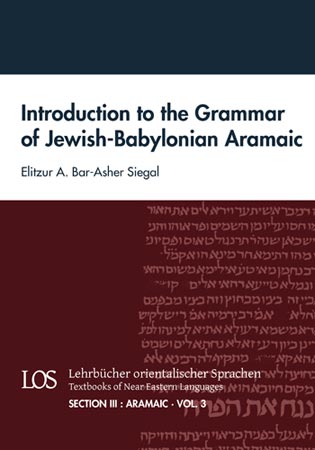I took Aramaic last year and really enjoyed it. In addition to the biblical texts, we translated some older Aramaic inscriptions and I got to see a bit of the diachronic development of the language. But I was quite a bit removed from Jewish-Babylonian Aramaic, the language of the Babylonian Talmud.
 Siegal’s grammar, Introduction to the Grammar of Jewish-Babylonian Aramaic, seeks to introduce the student to this period of Late Aramaic. He divides Aramaic (following Fitzmyer) into the following periods in his introduction:
Siegal’s grammar, Introduction to the Grammar of Jewish-Babylonian Aramaic, seeks to introduce the student to this period of Late Aramaic. He divides Aramaic (following Fitzmyer) into the following periods in his introduction:
Old Aramaic (925-700 BC)
Official Aramaic (799-200 BC)
Middle Aramaic (200 BC – AD 200)
Late Aramaic (AD 200-700)
Modern/Neo-Aramaic (700 CE)
The Late Aramaic period is the period of Jewish-Babylonian Aramaic, although he notes that the distinction between Middle and Late Aramaic has more to do with written conventions than oral dialects (22).
There are four corpora of Jewish-Babylonian Aramaic texts that have survived. The Babylonian Talmud is the major source. The Geonic literature includes rabbinic works written after the completion of the Talmud (seventh century AD) but before Babylonia ceased to be the center of Rabbinic Judaism, somewhere between 700-1100 AD. Most of the texts are responsa, legal opinions based on specific inquiries, but some are treatises on the law. The third corpus is the Writings of Anan ben David (8th century AD), the founder of the Karaites/Ananites, a Jewish sect that rejected rabbinic authority and that composed Sefer-ha-Mitzvot, a commentary on the Pentateuch. The fourth corpus includes incantation bowls with engravings of magical formulae. These are the only writings that are completely preserved from the time of their composition (rather than through copies made by scribes), but there is considerable disagreement on the linguistic value of these writings, whether they are complete gibberish or actual instances of natural Aramaic. Siegal’s work focuses on the first two corpora, but deals with the latter two when they provide helpful data.
I only read the introduction and skimmed the contents of this grammar (so it’s not a full review), and I would not be equipped to read and review his grammar anyway! I know nothing about Jewish-Babylonian Aramaic, but when I saw this book I grabbed it to get a quick orientation to a different period of Aramaic and understand the issues involved in the language. Siegal helpfully includes discussion of recent scholarship on the language, including variations within Jewish-Babylonian Aramaic (23-26), linguistic influences on this period of Aramaic (Hebrew, Akkadian, Persian, and Arabic [26-27]), and the various manuscripts of the Babylonian Talmud. I was surprised to find that there is only one extant manuscript (MS Munich 95) that contains the entire Babylonian Talmud, and that there has been one definitive edition (Vilna edition) reprinted since the mid-nineteenth century. The Vilna edition and other prints were all eclectic, and the conjectural emendations suggested by rabbinic consultants were included in the edition but not notated, so we have no justification for their text-critical decisions. For that reason, the Vilna edition (and others) of the Babylonian Talmud are not reliable sources of Jewish-Babylonian Aramaic (31).
As Siegal notes, there is still much work to be done on this language, including methodological discussion about the use of sources and the examination of all the extant manuscripts. This grammar is not definitive, but an attempt to contribute to the discussion about the language and make some positive suggestions for problematic areas.
He does make this grammar reader- and student-friendly (it arose out of teaching the language at Harvard and Yale). He includes a glossary at the end of the book to define linguistic terms. He also orders the book pedagogically and includes vocabulary notes and translation exercises to coincide with each chapter. He includes many charts and writes for students, rather than for sheer technicality.
The chapters cover all aspects of morphology, grammar, orthography, apocopation, nominal inflection, morphology including entire chapters on strong and weak verbs, moods, special verbs such as “to be,” and more content that you would normally find in a grammar. Although I am no Aramaic expert, and I have no knowledge of this period of Aramaic, this grammar seems like a useful addition to our knowledge of Jewish-Babylonian Aramaic and a solid resource for anyone needing to learn the language for, say, Talmudic studies. Anyone interested in the Aramaic language may also want to invest in this resource to see how the language has evolved through time. I’m glad I took the time to browse through it and learn a good deal about the language.
